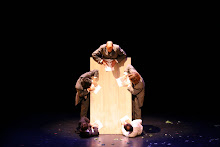
Heaven 2 is the result of a choreographic transformation, a process that began with Heaven in March of 2006, as result of the adaptation of an earlier choreography called The Guests.
The Guests was premiered in the year 2000 in Porto. The cast was constituted by seven dancers and three extras. The research period had taken eight months and the rehearsal period two months. When I arrived to the studio I worked most of the time as what Jo Butterworth calls the “Choreographer as an expert”, this means I had absolute control over the concept, style and structure of the piece, guiding at the same time the performers in their interpretation (2004: 55).
Unfortunately we just had two performances and it was impossible to tour with it because the large cast made the piece expensive for travelling.
When I was invited to make a co-production this year with the Festival Arena in Erlangen, Germany, I was eager to make a new version of this choreography, this time for actors. The core of the theme stayed the same; I kept my favourite scenes and created new ones. The result was a completely new piece and my approach as a choreographer was more as an author at times, which means that I had the whole control of the piece but “in relation to capabilities and qualities of the performers” (Butterworth 2004: 55).
I took the original “script” and applied it to a more concrete situation. Four business men arrive to a dinner without knowing who had sent the invitation or why they were invited. They have never seen each other before and a clear power game develops between them. I maintained the figure of the butler, not as a representation of death, but of change- a kind of devil of transformation.
The choice of making a new adaptation of this choreography for my Masters course came from the interest of exploring the piece with dancers; my intent was to maintain the theme of the piece intact as well as most of the frame of the scenes and to develop its language into dance movement. My aim was to explore if this approach enriches or not a choreography that had been done for actors. I wanted to change my approach as a choreographer, letting much more freedom to the dancers for their interpretation and suggestions, which would make me according to Butterworth’s word a “choreographer as a pilot”, where there is an “active participation from both parties” (2004:55).
As far as the general expressive character of the piece, I maintained it as if it were a silent movie. This means exaggerating the facial expressions and playing with surreal pauses or tempos, something that had been done already in the German Expressionist Theatre.
"For the actors of Expressionist theatre, the issue was not only linguistic sensitivity to the text but also physical sensitivity to the plastic rhythms of the performance space. Movement and vocalization took on and became part of the total poetic form that constituted the staging of Expressionism’s sometimes symbolic, sometimes allegorical, but never realistic dramatic world".
(Kuhns 19997: 92)
During the sixties and seventies, avant-garde choreographers tended to reject theatre and narrative elements. By doing this they were placing themselves away from ballet and modern dance. In recent years, “post-modern dance has moved from denying theatricality to embracing it” (Banes 1994: 252). I have been experimenting with theatre now for many years, not just in choreographies done for dancers, but combining different kind of performers such as musicians, singers and actors. If someone would ask me how I would label my choreographies, then I would say they are “post-modern”.
Although Heaven 2 is not innovative, it has an individual signature and is a personal exploration. While the amount of time of rehearsals was too short for what I would have liked to achieve with professional dancers, nevertheless I am able to see the potential that this piece could have with more movement.
I thank all my marvelous colleagues for their great input and interpretation. You guys made this project possible, a miracle in so short time! Love you
Francisco Pedro
Sveinborg Porhalld
Keith-Derek Randolph
Joshua Trebi
Aphrodite Vervenioti
Banes, Sally (1994) Writing Dancing in the Age of Postmodernism,
USA: Wesleyan University Press
Barba, Eugenio (1991[1999]) A Dictionary of Theatre Anthropology,
London: Routledge
Butterworth, Jo (2004) Research in Dance Education. Vol 5, nº1,
ISSN 1464-7893 (print)
UK: Taylor & Francis Ltd
Kuhns, David (1997) German Expressionist Theatre. The actor and the stage,
UK: Cambridge University Press





No comments:
Post a Comment